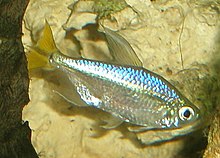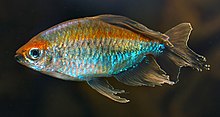African tetras
| African tetras | ||||||||||||
|---|---|---|---|---|---|---|---|---|---|---|---|---|

Blue Congo Tetra ( Phenacogrammus interruptus ) and Yellow Congo Tetra ( Alestopetersius caudalis ) |
||||||||||||
| Systematics | ||||||||||||
|
||||||||||||
| Scientific name | ||||||||||||
| Alestidae | ||||||||||||
| Roberts , 1969 |
The African tetra (Alestidae, older spelling Alestiidae), also called bigeye tetra , are a family of the order of the tetra-like . The fish live in the fresh waters of tropical and subtropical Africa , most species come from the Congo river basin . Some species are very beautiful and popular freshwater ornamental fish .
features
Bigeye tetra have an elongated, sometimes slightly high-backed body that is covered with cycloid scales. Most species are large-eyed and have large dorsal fins. An adipose fin is present. The mouth is often slightly above. The animals have two rows of teeth on the premaxillary ( Bryconaethiops has three), the second with molar teeth ( Gr .: "Alestes" = to grind). The maxillary is toothless. African tetra of the former subfamily Alestinae are 3.2 to 60 centimeters long, the former Hydrocyninae reach lengths of half a to 1.35 meters. Specimens up to 1.50 meters have been caught in the giant tiger tetra .
Way of life
Most African tetras live as schooling fish in lakes and rivers. They feed primarily on insect larvae and other small aquatic life. Some species also eat plants. The large species of the Hydrocynus genus eat smaller fish. African tetras spawn in groups or in pairs in open water or between aquatic plants. The eggs sink to the bottom or stick to the plants.
Internal system
|
The internal systematics of the Alestidae according to Arroyave & Stiassny 2011
|
The internal system of the African tetra is still controversial today. One suggestion is to place the large, piscivorous tiger fish ( Hydrocynus ) in a separate subfamily (Hydrocyninae) and all other African tetras in another (Alestinae), another four genera of large and medium-sized species ( Alestes, Brycinus, Bryconaethiops and Hydrocynus ) in one tribe (Alestiini) and the smaller ones in another (Petersiini). For the latter, the absence of a multi-pointed, molar-shaped dentition and the pronounced sexual dimorphism present in many species are given as a feature . The toothing is considered to be the original feature but cannot be used to clarify the internal relationships between the subgroups.
The right Kladogramm detected by the comparison of two markers of mitochondrial and nuclear - DNA , results in the evaluation of the data sets on the principle of maximum parsimony (Parsimony). If they are calculated using the Bayesian statistics method, the result is almost the same cladogram, only Alestes and Hydrocynus are then sister genera . DNA of the genera Petersius and Virilia were not available.
For two more, monotypic genera with the African Großschuppensalmler ( Arnoldichthys spilopterus ) and the Adonis Tetra ( Lepidarchus adonis ) as a species that calculations showed they apparently did not belong to the Alestidae but the South American in a large clade tetras are, the African Großschuppensalmler as a relative the American pike tetra (Ctenoluciidae), the Adoniss tetra basal to a clade of Chalceus , the Acestrorhynchidae and the real tetras (Characidae).
Genera and species
A total of about 115 species belong to the African tetras.
- Genus Alestes Müller & Troschel, 1844
- Alestes ansorgii Boulenger 1910
- Alestes baremoze (Joannis 1835)
- Alestes dentex (Linnaeus 1758)
- Alestes inferus Stiassny, Schelly & Mamonekene 2009
- Alestes liebrechtsii Boulenger 1898
- Alestes macrophthalmus Günther 1867
- Alestes stuhlmannii pepper 1896
- Genus Alestion Roberts, 2019
- Alestion rapax Roberts, 2019
- Genus Alestopetersius Hoedeman, 1951
 Yellow Congo Tetra ( Alestopetersius caudalis )
Yellow Congo Tetra ( Alestopetersius caudalis )- Alestopetersius bifasciatus (Poll, 1967)
- Alestopetersius brichardi Poll, 1967
- Yellow Congo Tetra ( Alestopetersius caudalis (Boulenger, 1899) )
- Alestopetersius compressus (Poll & Gosse, 1963)
- Alestopetersius conspectus Mbimbi & Stiassny, 2012
- Alestopetersius hilgendorfi (Boulenger, 1899)
- Alestopetersius leopoldianus (Boulenger, 1899)
- Alestopetersius nigropterus Poll, 1967
- Alestopetersius smykalai Poll, 1967
- Alestopetersius tumbensis Hoedeman, 1951
- Genus Arnoldichthys Myers, 1926
- African large-scale tetra ( Arnoldichthys spilopterus (Boulenger, 1909) )
- Genus Bathyaethiops Fowler, 1949
- Bathyaethiops atercrinis Mamonekene & Stiassny, 2012
- Bathyaethiops baka Moritz & Schliewen, 2016
- Bathyaethiops breuseghemi (Poll, 1945)
- Bathyaethiops caudomaculatus (Pellegrin, 1925)
- Bathyaethiops flammeus Moritz & Schliewen, 2016
- Bathyaethiops greeni Fowler, 1949
- Genus Brachypetersius Hoedeman, 1956
 Longfin tetra ( Bryconalestes longipinnis )
Longfin tetra ( Bryconalestes longipinnis )- Brachypetersius altus (Boulenger, 1899)
- Brachypetersius cadwaladeri (Fowler, 1930)
- Brachypetersius gabonensis Poll, 1967
- Hulot's Congo Tetra ( Brachypetersius huloti (Poll, 1954) )
- Brachypetersius notospilus (Pellegrin, 1930)
- Brachypetersius pseudonummifer Poll, 1967
- Genus Brycinus Cuvier & Valenciennes, 1849
-
B. macrolepidotus group
- Brycinus brevis (Boulenger 1903)
- Brycinus carmesinus (Nichols & Griscom 1917)
- Brycinus grandisquamis (Boulenger 1899)
- Brycinus macrolepidotus Valenciennes 1850
- Brycinus poptae (Pellegrin 1906)
- Brycinus rhodopleura (Boulenger 1906)
-
B. Nurse group
- Brycinus abeli (Fowler 1936)
- Brycinus affinis (Günther 1894)
- Brycinus bimaculatus (Boulenger 1899)
- Brycinus carolinae (Paugy & Lévêque 1981)
- Brycinus comptus (Roberts & Stewart 1976)
- Brycinus epuluensis Decru, Vreven, Sadio & Snoeks 2016
- Brycinus ferox (Hopson & Hopson 1982)
- Brycinus fwaensis Géry 1995
- Brycinus imberi (Peters 1852)
- Brycinus jacksonii (Boulenger 1912)
- Brycinus kingsleyae (Günther 1896)
- Brycinus minutus (Hopson & Hopson 1982)
- Brycinus nigricauda (Thys van den Audenaerde 1974)
- Brycinus nurse (Rüppell 1832)
- Brycinus opisthotaenia (Boulenger 1903)
- Brycinus peringueyi (Boulenger 1923)
- Brycinus taeniurus (Günther 1867)
-
B. macrolepidotus group
- Genus Bryconaethiops Günther, 1873
- Bryconaethiops boulengeri Pellegrin 1900
- Bryconaethiops macrops Boulenger 1920
- Bryconaethiops microstoma Günther 1873
- Bryconaethiops quinquesquamae Teugels & Thys van den Audenaerde 1990
- Bryconaethiops yseuxi Boulenger 1899
- Genus Bryconalestes Hoedeman, 1951
- Bryconalestes bartoni (Nichols & La Monte 1953)
- Bryconalestes derhami (Géry & Mahnert 1977)
- Bryconalestes humilis (Boulenger 1905)
- Bryconalestes intermedius (Boulenger 1903)
- Bryconalestes lateralis (Boulenger 1900)
- Bryconalestes leuciscus (Günther 1867)
- Longfin Salmer ( Bryconalestes longipinnis (Günther 1864))
- Bryconalestes luteus (novel 1966)
- Bryconalestes sadleri (Boulenger 1906)
- Bryconalestes tessmanni (Pappenheim 1911)
- Bryconalestes tholloni (Pellegrin 1901)
- Genus Clupeocharax Pellegrin, 1926
- Clupeocharax schoutedeni Pellegrin, 1926
- Genus Hemigrammopetersius Pellegrin, 1926
- Hemigrammopetersius barnardi (Herre, 1936)
- Hemigrammopetersius pulcher (Boulenger, 1909)
- Genus Hydrocynus Cuvier, 1816
- Hydrocynus brevis Günther 1864
- Hydrocynus forskahlii (Cuvier 1819)
- Giant tiger tetra (Hydrocynus goliath Boulenger 1898)
- Hydrocynus tanzaniae Brewster 1986
- Tiger tetra (Hydrocynus vittatus Castelnau 1861)
- Genus Ladigesia Géry, 1968
- Ladigesia roloffi Géry, 1968
- Genus Lepidarchus Roberts, 1966
- Adonis Tetra ( Lepidarchus Adonis Roberts 1966 )
- Genus Micralestes Boulenger, 1899
- Micralestes acutidens (Peters, 1852)
- Micralestes ambiguus Géry, 1995
- Micralestes argyrotaenia Trewavas, 1936
- Micralestes comoensis Poll & Roman, 1967
- Micralestes congicus Poll, 1967
- Micralestes eburneensis Daget, 1965
- Micralestes elongatus Daget, 1957
- Micralestes fodori Matthes, 1965
- Micralestes holargyreus (Günther, 1873)
- Micralestes humilis Boulenger, 1899
- Micralestes lualabae Poll, 1967
- Micralestes occidentalis (Günther, 1899)
- Micralestes schelly Stiassny & Mamonekene, 2007
- Micralestes stormsi Boulenger, 1902
- Micralestes vittatus (Boulenger, 1917)
- Genus Nannopetersius Hoedeman, 1956
 Ansorges Congo Tetra ( Nannopetersius ansorgii )
Ansorges Congo Tetra ( Nannopetersius ansorgii )- Ansorges Congo Tetra ( Nannopetersius ansorgii (Boulenger, 1910) )
- Nannopetersius lamberti Poll, 1967
- Nannopetersius mutambuei Lunkayilakio & Vreven, 2008
- Genus Petersius Hilgendorf, 1894
- Petersius conserialis Hilgendorf, 1894
- Genus Phenacogrammus Eigenmann, 1907
 Blue Congo Tetra ( Phenacogrammus interruptus ), male
Blue Congo Tetra ( Phenacogrammus interruptus ), male- Phenacogrammus aurantiacus (Pellegrin, 1930)
- Blehers Congo tetra ( Phenacogrammus bleheri Géry, 1995 )
- Brown Congo Tetra ( Phenacogrammus deheyni Poll, 1945 )
- Blue Congo Tetra ( Phenacogrammus interruptus (Boulenger, 1899) )
- Phenacogrammus major (Boulenger, 1903)
- Phenacogrammus polli Lambert, 1961
- Phenacogrammus stigmatura (Fowler, 1936)
- Phenacogrammus taeniatus Géry, 1996
- Phenacogrammus urotaenia (Boulenger, 1909)
- Genus Rhabdalestes Hoedeman, 1951
- Rhabdalestes aeratis Stiassny & Schaefer, 2005
- Rhabdalestes brevidorsalis (Pellegrin, 1921)
- Rhabdalestes leleupi Poll, 1967
- Rhabdalestes maunensis (Fowler, 1935)
- Rhabdalestes rhodesiensis (Ricardo-Bertram, 1943)
- Rhabdalestes septentrionalis (Boulenger, 1911)
- Rhabdalestes tangensis (Lönnberg, 1907)
- Rhabdalestes yokai Ibala Zamba & Vrewen, 2008
- Genus Tricuspidalestes Poll, 1967
- Tricuspidalestes caeruleus (Matthes, 1964)
- Genus Virilia Roberts, 1967
- Virilia pabrensis (novel 1966)
literature
- Günther Sterba : Freshwater fish in the world . Urania Verlag., Leipzig 1990; Licensed edition for Weltbild Verlag GmbH, Augsburg 1995, ISBN 3-89350-991-7 .
- Melanie Stiassny, Guy Teugels & Carl D. Hopkins: The Fresh and Brackish Water Fishes of Lower Guinea, West-Central Africa, Volume 1. ISBN 9789074752206 .
Individual evidence
- ↑ a b c Jairo Arroyave, Melanie LJ Stiassny: Phylogenetic relationships and the temporal context for the diversification of African characins of the family Alestidae (Ostariophysi: Characiformes): Evidence from DNA sequence data. Molecular Phylogenetics and Evolution, Volume 60, Issue 3, September 2011, doi: 10.1016 / j.ympev.2011.04.016
- ↑ Stiassny, Teugels & Hopkins (2007), pp. 381-383.
- ↑ Fricke et al .: Eschmeyer's Catalog of Fishes: Genera, Species, References. Accessed July 30, 2020 .
- ↑ Mbimbi MM, JJ & Stiassny, MLJ (2012): A new Alestopetersius (Characiformes: Alestidae) from the Kwilu River (Kasai basin) of central Africa; with a phylogeny for the genus and synonymy of Duboisialestes . Zootaxa , 3166: 59-68. PDF
- ↑ a b Paugy, D .: Révision systématique des Alestes et Brycinus africains (Pisces, Characidae). Collection Etudes et Théses. Editions de l'ORSTOM, Paris., 1986 ( ird.fr [PDF]).
- ^ Zanata, AM and RP Vari (2005): The family Alestidae (Ostariophysi, Characiformes): a phylogenetic analysis of a trans-Atlantic clade. Zoological Journal of the Linnean Society v. 145: 1-144.
Web links
- African tetras on Fishbase.org (English)



